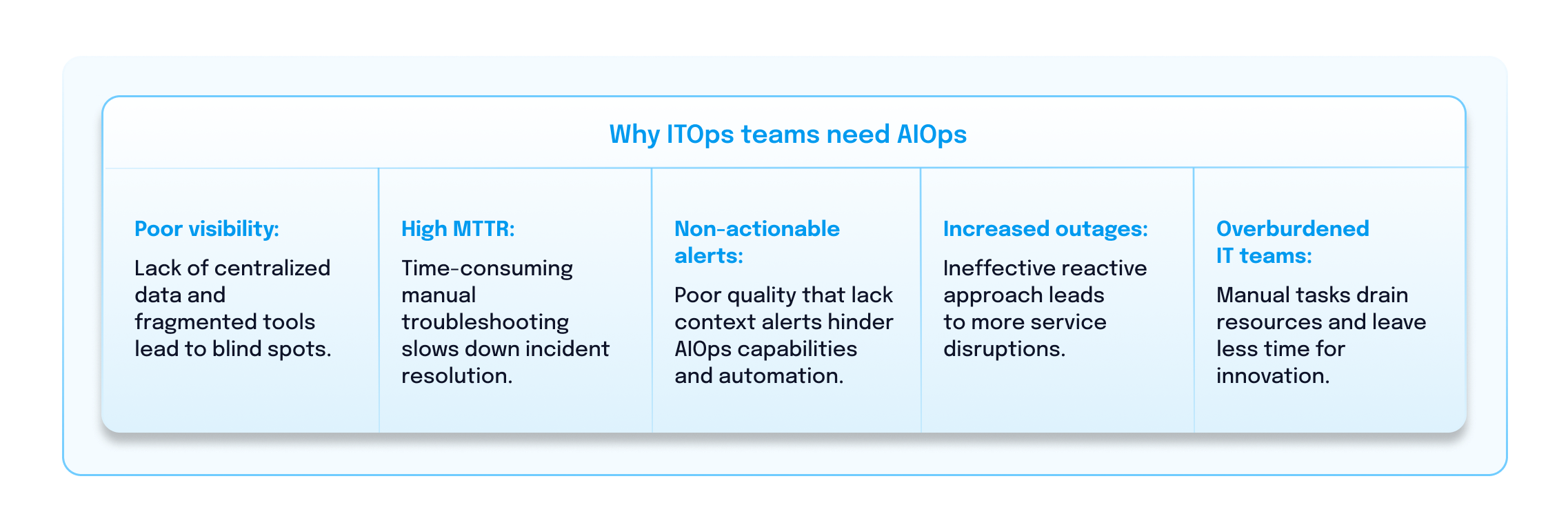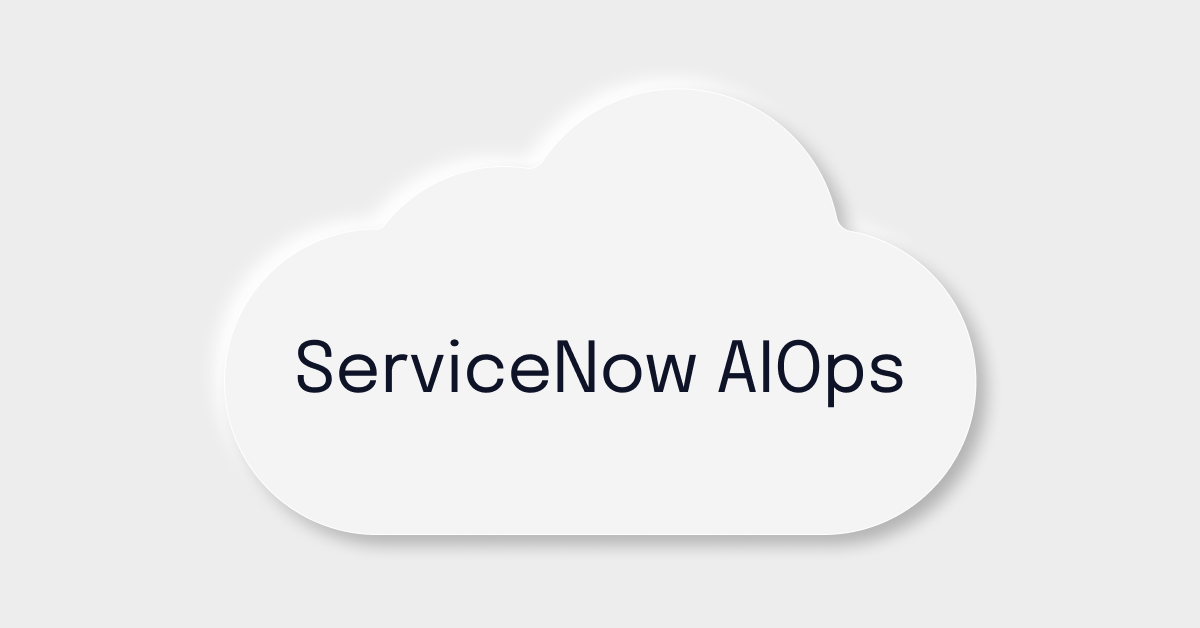Could ServiceNow’s AIOps be the solution to anticipate incidents better, minimize events, and slash your resolution time? When deployed correctly, this popular AIOps tool offers many benefits to IT operations teams.
We’ll explain everything you need to know to understand ServiceNow AIOps, its main product features, benefits, and common use cases. Discover how AIOps outperforms traditional IT operations tools in today’s dynamic IT environment.
What is ServiceNow AIOps?
ServiceNow AIOps proactively uses AI and ML to address IT operations challenges. It is part of the ServiceNow IT Operations Management (ITOM) suite and enables IT operations to go from reactive to preventative.
ServiceNow AIOps uses AI and ML to automate tasks, provide predictions from past data, and enhance IT service delivery and management. This is part of a significant shift as today’s IT operations and NOC teams shift from reactive problem-solving to proactive problem prevention.
Why use AIOps for IT operations?
AIOps tools assist IT operations by utilizing AI to analyze large amounts of data. They identify significant issues and determine their causes. Additionally, these tools automate tasks, resulting in time and resource savings.
Using AI, teams can predict and prevent outages, maintain service performance, and avoid manual work. This allows them to concentrate on strategic innovation and improving user experience rather than reacting to incidents. These are just some of the countless reasons teams are shifting from ITOps to AIOps.

What are ServiceNow’s AIOps products and features?
ServiceNow offers comprehensive AIOps capabilities as part of their ITOM platform which integrates with other ServiceNow products and services.
Their primary AIOps offering, Predictive AIOps, is an AIOps tool that can proactively identify issues in your IT environment. It uses AI, ML, and historical data to learn your normal environment and tell you when something goes wrong.
The main product features of ServiceNow AIOps include:
- Event management
- Log analysis and anomaly detection
- Metric analytics
This AIOps applies machine-learning algorithms to your logs, traces, and metric data to identify, diagnose, and help resolve service issues and anomalies in IT environments. These algorithms use data to learn, improve anomaly detection, analyze the correlation between different events, and determine the main cause of issues, enabling you to maintain quality, reliable digital services.
What are the main benefits of ServiceNow AIOps?
ServiceNow AIOps offers a suite of features leveraging AI and machine learning to address IT operations challenges. Its core functionalities fall into three key areas:
- Predictive insights: ServiceNow analyzes real-time data from diverse sources, including logs, monitoring tools, and workflows. Anomaly detection algorithms identify potential issues early on, enabling proactive intervention.
- Automated remediation: When identifying potential issues, ServiceNow AIOps can trigger automated workflows to help address them. These workflows can handle tasks like adjusting configurations or notifying personnel to fix issues and minimize downtime.
- Enhanced collaboration: Real-time data and a shared knowledge base enhance organizational visibility and transparency. Integrations with modules like Incident Management and Change Management ensure coordinated action.
ServiceNow AIOps functionalities of predictive insights, automated remediation, and collaboration offer intriguing possibilities for managing and shaping the future of digital infrastructure.
Customer use cases for ServiceNow AIOps
Customers use ServiceNow AIOps to address various IT operational challenges. These can vary significantly by industry and team capacities, but they typically aim to:
- Decrease reactive troubleshooting and manual efforts: Analyze IT operations data to anticipate and resolve issues before they escalate. By proactively addressing potential disruptions, AIOps minimize service interruptions and enhance the user experience.
- Improve business agility and resilience: AIOps provides a more robust IT infrastructure. Faster resolution of IT issues directly correlates with improved service uptime, supporting continuous business operations and reducing the risk of costly downtimes.
- Decrease resource use: Organizations can realize cost savings through optimized resource utilization and reduced operational downtime with AIOps. This makes IT operations more efficient and less resource-intensive.
Customers often integrate ServiceNow and BigPanda together to enhance IT operations and incident management. Global communications company Zayo can now automatically process huge event noise by using ServiceNow with BigPanda Alert Intelligence. Similarly, software giant Autodesk used these integrations together to reduce incidents by 69% and improve MTTR by 85%.
It’s time to shift from ITOps to AIOps
ServiceNow AIOps is part of a significant shift in modern IT operations towards proactive problem prevention through AI and automation.
AIOps addresses the complexities IT teams face in managing complex and fast-moving environments. By leveraging AIOps solutions, organizations can strive for more efficient and effective IT operations in an ever-evolving technological landscape.
Learn how to begin your journey with our ebook, Turbocharge your AIOps Maturity. This outlines your roadmap for starting with AIOps and automating incident management.
Enhance your AIOps with the BigPanda ServiceNow Integration
The BigPanda AIOps platform empowers ITOps teams in their ServiceNow deployment by delivering incidents enriched with deep context.
BigPanda works with ServiceNow via a seamless two-way synchronization to streamline processes. It enhances processes by automating alert correlation, noise reduction, contextualizing alerts, automating root cause analysis, and offering valuable business insights.

Try our demo and see how integrating BigPanda and ServiceNow AIOps can provide your IT operations teams with a powerful combination of proactive incident management and enhanced automation.




